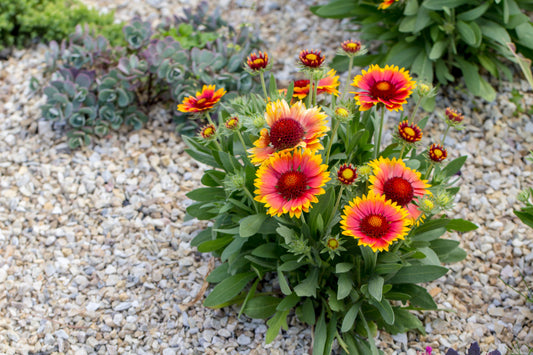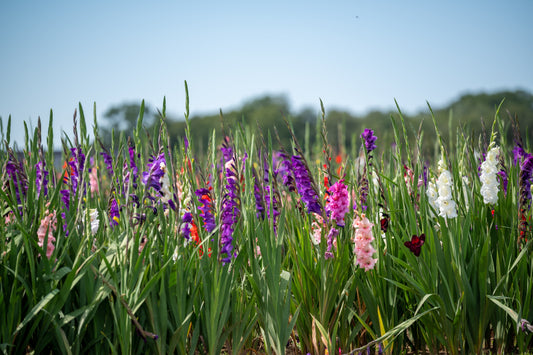Dahlia Planting & Growing Guide
Planting Guide Information
-
Tubers 4"; Crown around soil linePlanting Depth
-
18-24" ApartPlanting Proximity
-
SpringPlanting Season
-
Dahlias offer some of the best cut flowers around!Plant Benefits
-
ModerateWater Quantity
-
Summer to FallBloom Season
-
Full SunSunlight Quantity
-
Zones 8-11Hardiness Zones
Additional Growing Information
Where to Plant
While Dahlias are well-suited to both container and in-ground plantings, they won't thrive in soggy areas and prefer soil that is rich enough to support their "heavy feeding" needs. Therefore, if you notice water puddles 5–6 hours after a hard rain, it's best to scout out another site or amend the soil with organic material. Site your Dahlias where they will receive full sun for the strongest stems and greatest flower production.
When to Plant
Dahlia tubers are best planted in the spring but be mindful to wait until the soil warms up to 60 degrees F and the danger of frost has passed. They are winter hardy in zones 8–11, which means those gardening in zones 2–7 can either treat them as annuals or dig them up for winter storage. If you're eager to get a jump on the growing season, start your tubers indoors in containers before moving them outside.
How to Plant
- For outdoor landscape planting, find a location where the soil drains well, and your Dahlias will receive full sun. Check the mature size and spacing information provided for each variety and design your placement accordingly. Dig holes and plant the tubers 3–4" deep, with the eyes facing up and the crown near the soil line, and 18–24" apart, depending on the variety. Tuck the plants in and tamp down the soil to remove any air pockets.
- For container planting, select a pot with adequate drainage holes that's large enough to accommodate the mature size of your Dahlias. Use the information provided for each cultivar to choose varieties that grow to 2' or less. Fill your containers with well-drained, humus-rich potting soil, adding perlite or finely ground bark to improve drainage as needed. Dig holes and plant the tubers 3–4" deep, with the eyes facing up and the crown near the soil line, and 18–24" apart, depending on the variety. Tuck the plants in and tamp down the soil to remove any air pockets. Site your plants where they will receive full sun.
- Water generously after planting to settle the soil around the tubers.
How to Grow
- Water periodically during the growing season, as needed, bearing in mind that weekly deep waterings are better than lighter sips every few days. An estimate of 1" of moisture per week is a good place to start.
- Leave the foliage in place after blooming has finished for the season. The leaves gather sunlight, create food through photosynthesis, and strengthen the plant for the future.
- Pull up the plants after the first frost if you live in an area where the soil freezes and wish to save your tubers for next year.
- Trim out the dead stems or spent flowers to keep your plants looking their best if you live in an area where the weather stays warm year-round.
- Allow your Dahlias to rest for a few months before beginning the next growing cycle.
Dahlia Tips & Tricks
- Never allow your Dahlias to rest in waterlogged soil.
- Amend soil with compost, finely ground bark, or decomposed manure to raise the level 2–3" to improve the drainage.
- Provide support such as a sturdy stake for taller varieties or those with large blooms. Placing the stake at the time of planting helps ensure you don't damage the tuber.
- Expect root and top growth to form within a few weeks after planting, depending on the soil and air temperatures.
- Examine your Dahlia tubers to locate the point where the thick roots meet the stem. Notice any little "eyes" or growing points bumping out, as this is where the new shoots will form. Tubers vary in shape, and if you can't find the "eyes" to make them face upwards when planting, don't worry—there's still a good chance your Dahlias will bloom fine.
- Feel free to snip a few blossoms for exceptional bouquets while in bloom, as this will not hurt the plants. In fact, cutting flowers prolongs the flowering period for some varieties!
- Overwinter your tubers by rinsing off any excess soil, cutting the stems to 3", and letting them dry for 2–3 hours. Tuck them into paper bags or cartons filled with peat moss and place them in a cool, dry spot. If you notice them drying up, sprinkle a little water into the peat.
From the Family
-
 19% OffPreorder
19% OffPreorderDahlia - Smokey
3 Clumps of TubersRegular price $24.46Sale price $24.46 Regular priceUnit price per$29.9519% OffPreorder -
 19% OffPreorder
19% OffPreorderDahlia - Nick Sr.
3 Clumps of TubersRegular price $24.46Sale price $24.46 Regular priceUnit price per$29.9519% OffPreorder -
 16% OffPreorder
16% OffPreorderDahlia - Kelvin Floodlight
3 Clumps of TubersRegular price $25.46Sale price $25.46 Regular priceUnit price per$29.9616% OffPreorder -
 15% OffPreorder
15% OffPreorderDahlia - Purple Taiheijo
3 Clumps of TubersRegular price $25.46Sale price $25.46 Regular priceUnit price per$29.9515% OffPreorder -
 15% OffPreorder
15% OffPreorderDahlia - Cafe au Lait
3 Clumps of TubersRegular price $25.46Sale price $25.46 Regular priceUnit price per$29.9515% OffPreorder








